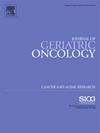Exercise interventions for older adults with advanced cancer: A scoping review
IF 3
3区 医学
Q3 GERIATRICS & GERONTOLOGY
引用次数: 0
Abstract
Introduction
The feasibility, safety, acceptability, and perceptions of exercise in older adults with advanced disease are not well understood due to the scarcity of evidence. This scoping review aimed to (1) summarize evidence on the feasibility, acceptability, and safety of exercise interventions for older adults with advanced cancer and (2) explore this population's perceptions on participating in exercise programs.
Materials and Methods
A systematic search was conducted by an expert research librarian in Medline, CINAHL, EMBASE, Cochrane CENTRAL, and SPORTDiscus (inception through November 2023). Eligible studies included older adults with advanced (stage IV or receiving treatment with non-curative intent) solid cancers and intervention or qualitative studies on physical activity/exercise in older adults pertaining to our objectives.
Results
A total of 36 studies were included: 28 (78 %) intervention studies, seven (19 %) qualitative studies, and one (3 %) cross-sectional study. The Frequency/Intensity/Time/Type (FITT) principle was described in 18 studies (64 %). Feasibility was examined in 15 of the 28 intervention studies (54 %) using various definitions. Four studies had predetermined feasibility thresholds, yielding mixed results. One intervention study reported on two intervention-related severe adverse events. Nineteen of the 28 intervention studies (68 %) examined acceptability, reporting high levels of participant satisfaction. Qualitative data revealed several barriers and facilitators to exercise.
Discussion
Exercise appears to be feasible, acceptable, and safe in older adults with advanced cancer. Consistent reporting on the FITT principle and feasibility operationalization are areas of improvement in exercise studies in older adults with advanced disease.
老年晚期癌症患者的运动干预:范围综述
由于缺乏证据,老年人晚期疾病运动的可行性、安全性、可接受性和认知尚未得到很好的理解。本综述旨在(1)总结运动干预对老年晚期癌症患者的可行性、可接受性和安全性的证据;(2)探讨老年人参与运动项目的看法。材料和方法由一位专家研究馆员在Medline、CINAHL、EMBASE、Cochrane CENTRAL和SPORTDiscus(成立至2023年11月)中进行系统检索。符合条件的研究包括晚期(IV期或接受非治愈性治疗)实体癌的老年人,以及与我们的目标相关的老年人身体活动/锻炼的干预或定性研究。结果共纳入36项研究:干预研究28项(78%),定性研究7项(19%),横断面研究1项(3%)。18项研究(64%)描述了频率/强度/时间/类型(FITT)原则。28项干预研究中有15项(54%)采用不同的定义进行可行性研究。有四项研究预先设定了可行性阈值,结果好坏参半。一项干预研究报告了两起与干预相关的严重不良事件。28项干预研究中有19项(68%)检查了可接受性,报告了高水平的参与者满意度。定性数据揭示了锻炼的几个障碍和促进因素。讨论运动对于老年晚期癌症患者似乎是可行的、可接受的和安全的。关于FITT原则和可行性操作的一致报告是老年晚期疾病患者运动研究的改进领域。
本文章由计算机程序翻译,如有差异,请以英文原文为准。
求助全文
约1分钟内获得全文
求助全文
来源期刊

Journal of geriatric oncology
ONCOLOGY-GERIATRICS & GERONTOLOGY
CiteScore
5.30
自引率
10.00%
发文量
379
审稿时长
80 days
期刊介绍:
The Journal of Geriatric Oncology is an international, multidisciplinary journal which is focused on advancing research in the treatment and survivorship issues of older adults with cancer, as well as literature relevant to education and policy development in geriatric oncology.
The journal welcomes the submission of manuscripts in the following categories:
• Original research articles
• Review articles
• Clinical trials
• Education and training articles
• Short communications
• Perspectives
• Meeting reports
• Letters to the Editor.
 求助内容:
求助内容: 应助结果提醒方式:
应助结果提醒方式:


